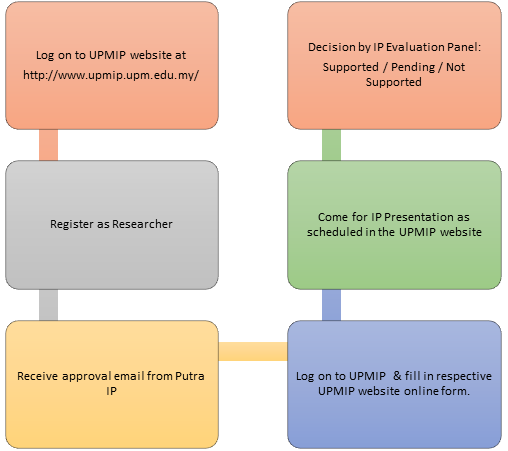Patentability : Through the Eyes of the IP Evaluation Panel
The Intellectual Property Division, Putra Science Park is entrusted to manage the valuable intangible assets of UPM. This is a must visit place for every inventor eyeing for patent and other intellectual property (IP) protection before the University would commercialize the IP for income generation. Researchers must first disclose their inventions internally before the University’s IP Evaluation Panel (Panel). The IP evaluation session is a weekly event. The process flow for an IP application within UPM is shown in Figure 1:
Figure 1: UPMIP Application Process Flow

There are legal and economic criteria that the Panel will look for depending on the type of the IP. In this Issue, the discussion will focus only to patents. Discussion for other type of IP will be continued in the next issue. For patent application, the legal criteria are patentability of the invention namely novelty, inventive step and industrial application.
For the novelty criterion, the Panel will consider the patentable invention, whether it is a new product (device or composition of matter), process (sequence or methodology), use or an improvement. Confirmation of novelty depends on the existence of relevant prior arts, which is the researchers’ responsibility to find them. The Putra IP Division provides assistance over enquiries on the prior arts searches technique. The invention is novel when it is not anticipated by the relevant prior art. The researchers must understand their invention according to the requirement of the patent law and be able to show through detailed drawings, formulas, and the like that their conceived idea actually works.
The prior arts taken together will also be used to determine if the invention has an inventive step. When the Panel is convinced that person with ordinary skill in the art (i.e. someone with fair level of experience) would not be likely to develop the same invention, then the invention is non-obvious and passed this test. Hence, if one could have arrived at the same invention after combining all the elements of separate prior arts, the obviousness test fails.
Industrial application will also be scrutinized where the researchers need to describe the applications in which industry will likely use the invention. This criteria is also relevant for the Panel to consider on the potential commercialization of the invention before supporting the filing of the invention at the Intellectual Property Corporation of Malaysia (MyIPO).
Updated:: 03/03/2021 [asrizam]
MEDIA SHARING






















